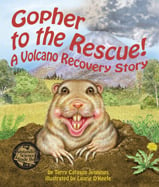Alignment to Standards for AZ

| Grade | Number | Standard |
|---|---|---|
| 1 | PO 2 | Compare the habitats (e.g., desert, forest, prairie, water, underground) in which plants and animals live. |
| 1 | PO 2 | Compare the following observable features of living things: movement _ legs, wings, protection _ skin, feathers, tree bark, respiration _ lungs, gills, support _ plant stems, tree trunks, |
| 1 | PO 2 | Identify characteristics of maps and globes: compass rose, symbols, map key/legend |
| 1 | PO 3 | Describe how plants and animals within a habitat are dependent on each other. |
| 1 | PO 3 | Identify observable similarities and differences (e.g., number of legs, body coverings, size) between/among different groups of animals. |
| 1,2 | PO 1 | Recognize different types of maps (e.g., political, physical) serve various purposes. |
| 1,2 | PO 4b | Recognize characteristics of human and physical features: human (i.e., equator, North and South Poles) |
| 1,2,3 | PO 5a | Locate physical and human features using maps, illustrations, images or globes: physical ((i.e., continent, ocean, river, lake, mountains, islands) |
| 1,2,3 | PO 5b | Locate physical and human features using maps, illustrations, images or globes: human (i.e., equator, North and South poles, country) |
| 1,2,3 | PO 6a | Recognize characteristics of human and physical features: physical (i.e., continent, ocean, river, lake, mountain range, coast, sea, desert, gulf, bay, strait, plain, valley, volcano, peninsula) |
| 2 | PO 1 | Identify animal structures that serve different functions (e.g., sensory, defense, locomotion). |
| 2,3 | PO 2 | Interpret political and physical maps using the following elements: alpha numeric grids, title, compass rose - cardinal directions, key (legend), symbols |
| 3 | PO 1 | Identify adaptations of plants and animals that allow them to live in specific environments. |
| 3 | PO 1 | Identify the layers of the Earth: crust , mantle, core (inner and outer) |
| 3 | PO 1 | Locate major physical and human features from content studied (e.g., Greece, Canada, Spain, United States) on maps and globes. |
| 3 | PO 2 | Describe ways that species adapt when introduced into new environments. |
| 3 | PO 2 | beneficial and harmful impacts of natural events and human activities on the environment (e.g., forest fires, flooding, pesticides). |
| 3 | PO 4 | Describe how plants and animals cause change in their environment. |
| 3 | PO 5 | environmental factors (soil composition, range of temperature, quantity and quality of light or water) in the ecosystem may affect a member organismês ability to grow, reproduce, and thrive. |
| 3 | PO 6b | human (i.e., Equator, Northern and Southern Hemispheres, North and South Poles, city) |
| 4 | PO 1 | Describe ways various resources (e.g., air, water, plants, animals, soil) are utilized to meet the needs of a population. |
| 4 | PO 1 | Recognize that successful characteristics of populations are inherited traits that are favorable in a particular environment. |
| 4 | PO 1 | Compare structures in plants (e.g., roots, stems, leaves, flowers) and animals (e.g., muscles, bones, nerves) that serve different functions in growth and survival. |
| 4 | PO 1 | Identify the Earth processes that cause erosion. |
| 4 | PO 1 | natural events and human activities have positive and negative impacts on environments |
| 4 | PO 2 | Give examples of adaptations that allow plants and animals to survive. camouflage _ horned lizards, coyotes, mimicry _ Monarch and Viceroy butterflies, physical _ cactus spines, mutualism _ species of acacia that harbor ants, which repel other harmful ins |
| 4 | PO 2 | Describe how currents and wind cause erosion and land changes. |
| 4 | PO 2 | Describe the impact of extreme natural events (e.g., fires, volcanoes, floods, droughts) on human and physical environments. |
| 4 | PO 2 | Evaluate the consequences of environmental occurrences that happen either rapidly (e.g., fire, flood, tornado) or over a long period of time (e.g., drought, melting ice caps, the greenhouse effect, erosion). |
| 4 | PO 4 | Earthês surface changes: rapid _ earthquakes, volcanoes, floods, slow _ wind, weathering |
| 4 | PO 5 | Identify the Earth events that cause changes in atmospheric conditions (volcanic eruptions, forest fires). |
| 4 | PO 5 | Describe how regions and places (e.g., Grand Canyon, Colorado River, Casa Grande Ruin, Canyon de Chelly, Yucatan Peninsula) have distinct characteristics. |
| 5 | PO 1 | Explain the impacts of natural hazards on habitats (e.g., global warming, floods, asteroid or large meteor impacts). |
| K | PO 1 | Recognize the differences between maps and globes. |
| K | PO 2 | Identify that plants and animals need the following to grow and survive: food, water, air, space, |
| K | PO 3 | Describe changes observed in a small system (e.g., ant farm, plant terrarium, aquarium). |
| K | PO 4 | Identify land and water on maps, illustrations, images, and globes. |
| K | PO 5 | Locate continents and oceans on a map or globe. |